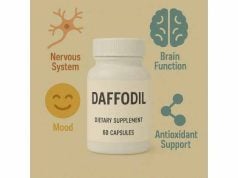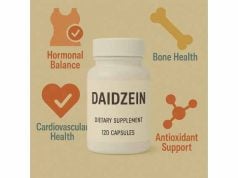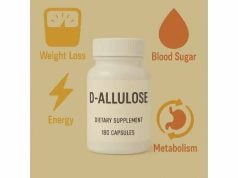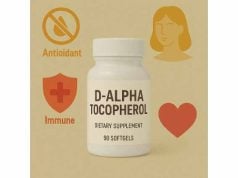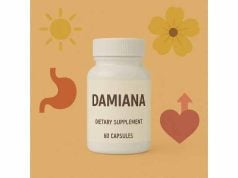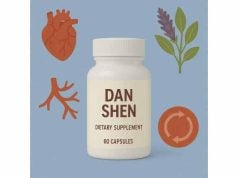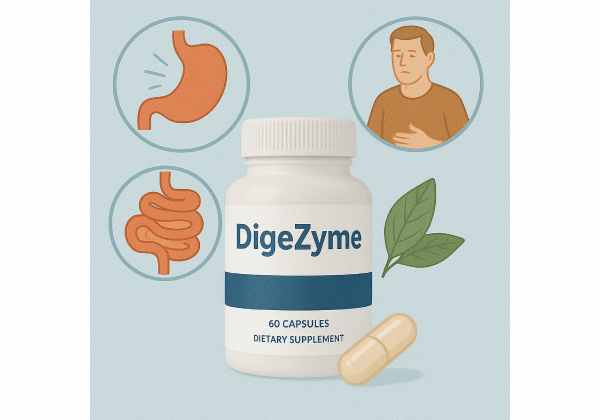
DigeZyme is a branded blend of digestive enzymes designed to help your body break down the major nutrients in food—carbohydrates, proteins, fats, lactose, and plant fibers—so you can absorb them more comfortably. It typically includes α-amylase, protease, lipase, lactase, and cellulase sourced from microbial fermentation. For people who struggle with indigestion, heavy meals, or occasional post-meal bloating, a targeted enzyme mix can support the work of your own digestive enzymes and ease symptoms. Small randomized trials suggest multi-enzyme supplements may reduce upper-abdominal discomfort and improve overall digestive quality of life, with good short-term tolerability. In this guide, you’ll learn exactly what DigeZyme is, how it works, realistic benefits, smart ways to use it, dose ranges seen in research and on labels, safety considerations, and what the evidence does—and does not—show.
Essential Insights for DigeZyme Users
- May reduce functional dyspepsia symptoms and post-meal discomfort in some adults.
- Typical use is with meals: 50–200 mg per meal (or 50 mg three times daily in one trial).
- Generally well tolerated; stop and seek care if pain, rash, or breathing issues occur.
- Avoid use or get medical advice first if you have pancreatitis, active ulcers, bleeding disorders, or mold/enzyme allergies.
Table of Contents
- What is DigeZyme and how it works
- Does DigeZyme really help digestion?
- How to take DigeZyme: dosage and timing
- Choosing and using DigeZyme for your needs
- Mistakes to avoid and troubleshooting
- Safety, side effects, and who should avoid
- Research summary: what the studies show
What is DigeZyme and how it works
DigeZyme is a proprietary multi-enzyme complex formulated to assist the digestion of the major macronutrients and some harder-to-handle food components. Its core enzymes are:
- α-Amylase (starch-digesting): helps break long carbohydrate chains (starches) into smaller sugars.
- Protease (protein-digesting): cleaves dietary proteins into peptides and amino acids.
- Lipase (fat-digesting): liberates free fatty acids and glycerol from dietary fats.
- Lactase (milk-sugar-digesting): splits lactose into glucose and galactose, which is especially relevant for people with lactose intolerance.
- Cellulase (fiber-digesting): helps degrade plant cell-wall cellulose to reduce residual fiber hardness; this does not “eliminate” fiber but can make high-fiber meals feel gentler.
These enzymes are typically derived from safe microbial fermentation (commonly Aspergillus species for amylase, protease, lipase, and lactase; and Trichoderma for cellulase). Microbial enzymes often remain active across a wider pH range than animal-derived pancreatin, which can be useful as the meal moves from the acidic stomach to the less-acid small intestine. Because enzymes are catalysts—not nutrients—they act on contact with food in the gut lumen and are not “absorbed” like vitamins or minerals. Their usefulness therefore depends on timing (with food), the pH environment, and the amount of target substrate in the meal.
What DigeZyme is not: it is not a medicine for diagnosed enzyme deficiency (for example, exocrine pancreatic insufficiency, which requires prescription pancreatic enzymes measured in lipase units). It is also not a cure for structural or inflammatory gastrointestinal diseases. Its role is supportive: to help your own digestive process handle normal meals more comfortably and, in some people, to decrease symptoms like upper-abdominal fullness, epigastric pain, or bloating after eating.
Mechanistically, users may notice less heaviness after starch- or fat-rich meals, fewer issues with dairy if lactose is a trigger, and a general sense of smoother digestion. Effects are meal-by-meal and wear off with the meal; there is no cumulative “build-up” like with probiotics. Response varies depending on what you eat, your underlying digestion, and whether symptoms are driven by motility, sensitivity, microbiota, or other factors.
Does DigeZyme really help digestion?
For a supplement, “does it work?” means: do people feel better and do validated symptom scores improve compared with placebo, with acceptable safety. Here’s what controlled trials suggest:
- Functional dyspepsia (FD): This common condition features epigastric discomfort, early fullness, or burning without visible lesions. In a randomized, double-blind, placebo-controlled trial of adults with FD, a DigeZyme-based multi-enzyme complex given for 60 days improved multiple dyspepsia outcomes versus placebo, including the Short-Form Leeds Dyspepsia Questionnaire, Nepean Dyspepsia Index, visual analog pain scores, and global impression ratings, with no supplement-related adverse effects reported. The regimen used small doses spread through the day, reflecting the idea that enzymes act when food is present.
- Multi-enzyme blends beyond one brand: A larger randomized trial (120 participants) tested a microbial multi-enzyme supplement for two months. Compared with placebo, participants reported better quality-of-life scores (Nepean Dyspepsia Index), lower pain ratings, and improved sleep quality, again with good tolerability. While this study did not use DigeZyme specifically, it reinforces that enzyme blends can be helpful in the same symptom cluster.
- Mechanistic support: In vitro digestion models that simulate the human stomach and small intestine show that adding microbial enzyme mixtures increases the release of reducing sugars from starch, free fatty acids from fats, and amino acids/peptides from proteins compared with digestion by endogenous enzymes alone. Newer protocols that better mimic dynamic gastric conditions (acidification and secretions over time) still find that exogenous enzymes can enhance macronutrient disassembly, providing a plausible mechanism for symptom relief after heavy or complex meals.
What to make of this as a consumer? The clinical signals are promising but modest. Enzymes are most likely to help if your symptoms flare with particular foods (dairy, very starchy or fatty meals, large salads rich in raw fibrous vegetables) and if you lack an underlying disease that needs other treatment. They tend not to fix reflux that is driven by a weak lower esophageal sphincter, nor do they address stress-related visceral sensitivity by themselves. In trials, benefits were observed over weeks, but many users notice within several meals whether enzymes help.
A practical expectation: reduced heaviness, less upper-abdominal discomfort, potentially less bloating, and smoother bowel habits—especially when meals are large or compositionally challenging. Lack of effect after two to three weeks of consistent, with-meal use suggests it may not be the right tool, and you should reassess with a clinician.
How to take DigeZyme: dosage and timing
When: Take enzymes with the first bites of a meal or up to 5–10 minutes before eating. They act locally on the food present; taking them on an empty stomach has little digestive value.
How much: Products list milligrams (mg) of the blend and activity units (how much work the enzymes can do). Activity units matter more than milligrams because enzyme potency varies by source. On labels you may see units like DU (amylase), HUT or PC (protease), FIP (lipase), ALU (lactase), and CU (cellulase). For general digestive support:
- Common label use: 50–200 mg of a multi-enzyme blend with meals.
- Research examples: One FD trial used 50 mg three times daily with meals for 60 days; another multi-enzyme trial used 200 mg per capsule, two capsules per day for two months.
- Lactose-heavy meals: If dairy is your main trigger, enzyme blends can help, but a dedicated lactase product (often 3,000–9,000 FCC units with the first bite) is more predictable for large dairy servings.
- High-fat meals: Ensure the product lists meaningful lipase activity.
- High-starch meals: Look for robust amylase units.
- High-fiber, plant-forward meals: Cellulase can help soften the feel of raw or very fibrous vegetables.
How long: You can evaluate your response over 2–3 weeks of consistent use with your typical meals. Many people use enzymes situationally (restaurants, holidays, travel) rather than daily.
With other supplements or medications: Enzymes pair logically with probiotics or gentle bitters for some people, but always introduce one change at a time so you can judge effect. If you use acid-suppressing drugs (PPIs), enzyme function may shift with pH; microbial enzymes often tolerate a broader pH range than pancreatin, but results can vary.
Enteric coating: Some enzyme products are enteric-coated to protect from stomach acid. Microbial enzymes can work in a wider pH range; both coated and non-coated formulas are used successfully. Follow the brand’s directions (some should not be opened or chewed).
Hydration and portion size: These basic habits matter. Smaller, well-chewed portions with adequate fluid reduce the “load” on your digestive tract and improve the odds you’ll notice a benefit from enzymes.
When to escalate: If you need multiple capsules for every routine meal, or symptoms persist despite correct timing, it’s time to reassess diet patterns and rule out conditions like H. pylori, celiac disease, gallbladder issues, or delayed gastric emptying.
Choosing and using DigeZyme for your needs
Not all enzyme blends are identical, even when they carry the same brand name in finished products. Use these criteria:
1) Match the blend to your meals
- Dairy-heavy days: Prioritize products that disclose lactase activity in ALU or FCC units.
- Steak-and-eggs or high-protein meals: Ensure strong protease activity (HUT/PC units).
- Fried or creamy meals: Look for higher lipase (FIP units).
- Pasta, rice, bread: Emphasize amylase (DU).
- Raw salads and legumes: Include cellulase, and consider separate alpha-galactosidase (for gas-forming oligosaccharides in beans).
2) Prefer transparent labeling
Choose products listing activity units per serving, not just milligrams. Milligram weight alone does not guarantee potency. If two products list the same mg but one discloses double the activity units, the latter is likely stronger.
3) Consider capsule count and lifestyle
Many people do well with one capsule per standard meal and skip for snacks. If breakfast is light and dinner is heavy, concentrate use at dinner.
4) Special scenarios
- Lactose intolerance: For pizza or ice cream, a dedicated lactase tablet can be combined with your multi-enzyme capsule.
- High-fiber plant-based diets: Enzymes can smooth the transition when increasing fiber intake; still raise fiber gradually and drink water.
- Older adults: Digestive capacity can decline with age. Enzymes may help meals feel lighter; start low, track response, and prioritize activity-unit transparency.
5) Co-formulations
Some products combine enzymes with herbs (e.g., ginger, peppermint). These may add comfort for some, but herbs can affect reflux or interact with medications. If you’re sensitive, stick to enzymes-only at first.
6) Storage and consistency
Heat and humidity degrade enzymes. Store tightly closed at room temperature away from moisture. Potency should be consistent to the labeled expiry.
7) Budget and value
Because activity units, not brand prestige, determine work done, compare cost per useable activity unit when labels allow. If labels lack units, consider choosing a more transparent product—even at a modest premium—because dosing is easier and results are more consistent.
Finally, remember that enzymes are adjuncts. If a particular food always disrupts you (e.g., very spicy dishes or large amounts of alcohol), enzymes won’t fully offset that trigger. Use them to widen your comfortable range, not to “override” your body’s signals.
Mistakes to avoid and troubleshooting
Mistake: Taking enzymes on an empty stomach.
Correction: Swallow with the first mouthful or within 5–10 minutes before eating so enzymes meet food in the stomach.
Mistake: Judging by milligrams alone.
Correction: Look for activity units (DU, HUT/PC, FIP, ALU, CU). If your product lists only mg, effects may vary between bottles or brands.
Mistake: Expecting enzymes to fix reflux or IBS overnight.
Correction: Enzymes can reduce load from hard-to-digest meals. Reflux often needs meal-timing, portion control, weight management, and sometimes medication. IBS may benefit from a structured diet (e.g., low-FODMAP trial) and stress-gut strategies alongside or instead of enzymes.
Mistake: Using the same dose for every meal.
Correction: Adjust to the meal size and composition. Big, fatty, or starchy meals may call for a full serving; small snacks may need none.
Mistake: Ignoring lactose unit needs.
Correction: If dairy triggers symptoms, ensure your enzyme choice provides meaningful lactase activity. For large dairy servings, a separate lactase can be more reliable.
Mistake: Stopping too soon or persisting too long.
Correction: Give a fair trial for 2–3 weeks of routine meals. If there is no clear benefit, stop and reassess rather than escalating indefinitely.
Troubleshooting quick guide
- Still bloated after salads/beans: Add alpha-galactosidase separately; keep cellulase in your blend; soak/pressure-cook legumes when possible.
- Greasy stools or floating stool: That suggests fat malabsorption; enzymes may help mild cases, but persistent symptoms warrant medical evaluation.
- Cramping or diarrhea after starting: Stop. You may be sensitive to a component or taking it without food. Re-challenge at half dose only if symptoms fully resolve.
- Heartburn worsens: Large, late dinners and alcohol matter more than enzymes. Move the main meal earlier; consider smaller portions with a short walk after eating.
Red flags to seek care now: unintended weight loss, anemia, black or bloody stool, nighttime pain, persistent vomiting, fever, difficulty swallowing, or pain that wakes you from sleep. Enzymes are not appropriate for undiagnosed “alarm” symptoms.
Safety, side effects, and who should avoid
Short-term randomized trials of multi-enzyme blends in adults reported good tolerability and no supplement-related serious adverse events. Most people take these products without issues when used as directed with meals.
Possible side effects (usually mild):
- Temporary changes in stool consistency, cramping, gas, or nausea—often from dose/timing mismatch or from challenging meals themselves.
- Allergic reactions are rare but possible—especially in people with known sensitivity to molds or fungal-derived enzymes. Signs include rash, itching, swelling, wheeze, or shortness of breath. Discontinue and seek care.
Who should avoid or seek medical advice first:
- Pancreatitis (current or recent), active peptic ulcer, unexplained GI bleeding, or major GI surgery—get specialist guidance first.
- Bleeding disorders or anticoagulant therapy—some proteolytic enzymes outside of digestive blends have theoretical bleeding risks; while typical digestive doses are low, discuss with your clinician if you are on warfarin or similar therapy.
- Severe food allergies—check excipients and enzyme sources.
- Pregnancy or breastfeeding—human safety data are limited; consider food-first strategies and ask your obstetric provider.
- Children—use only with pediatric guidance.
Drug interactions: Enzymes act in the gut lumen, and clinically significant interactions are uncommon at standard doses. Still, separate by at least an hour from enteric-coated medications if you are concerned about capsule coatings, and keep an updated medication list when consulting your clinician.
Quality considerations: Choose brands that undergo third-party testing, disclose activity units, and note storage conditions. Avoid moisture; do not use past the expiry date, as enzyme activity declines over time.
Bottom line on safety: For healthy adults using label-directed doses with meals, DigeZyme-type blends are generally low risk. Persistent pain, weight loss, or other red flags call for medical evaluation rather than continued self-supplementation.
Research summary: what the studies show
Clinical outcomes in functional dyspepsia
- A randomized, double-blind, placebo-controlled study in adults with functional dyspepsia tested a multienzyme complex containing α-amylase, protease, cellulase, lactase, and lipase for 60 days. Compared with placebo, participants receiving the enzyme complex had statistically significant improvements on several validated scales (short-form Leeds Dyspepsia Questionnaire; Nepean Dyspepsia Index; visual analog pain scores; clinical global impression; Glasgow Dyspepsia Severity Score). Investigators reported no product-related adverse events and no clinically significant lab changes. The dosing strategy used small, frequent enzyme amounts with meals—a practical pattern users can emulate.
- A larger RCT (n=120) evaluated a fungal-derived multi-enzyme blend for two months in adults with dyspepsia. Compared with placebo, the enzyme group improved quality-of-life (Nepean Dyspepsia Index), reduced pain severity, and showed better sleep quality (Pittsburgh Sleep Quality Index). Tolerability was good, with no safety signal. Although the blend was not DigeZyme specifically, the enzyme composition and mechanism were similar to branded multi-enzyme complexes, supporting the class effect.
Mechanistic and model data
- An in vitro study using both static and semi-dynamic digestion models found that adding a digestive enzyme supplement enhanced gastric disintegration of a complex meal, increased the release of reducing sugars, and improved protein and fat digestion compared with endogenous enzymes alone. These models better mimic real gastric conditions (gradual acidification and secretions) and provide a mechanistic basis for meal-specific symptom improvement.
- A 2025 open-access study in a model of digestive senescence showed that a mixture of microbial enzymes increased the bioaccessibility of amino acids, sugars, and glycerol from a mixed solid meal under “aging” conditions, complementing earlier INFOGEST-protocol work. Together, these findings explain why older adults or people eating dense, mixed meals might perceive benefits.
Context within digestive care
- A comprehensive review of digestive enzyme supplementation emphasizes that prescription pancreatic enzymes are the standard for exocrine pancreatic insufficiency, while microbial, plant-, and fungal-derived enzymes may assist otherwise healthy digestion or specific intolerances (like lactose) when used appropriately. The review underscores the importance of activity units and pH stability in choosing effective products.
What’s uncertain
- Evidence outside the dyspepsia/meal-comfort domain (e.g., athletic recovery) is limited and mixed, with small or lower-quality studies and few independent replications.
- Long-term outcomes beyond a few months are not well characterized.
- Trials vary in enzyme doses, activity units, and meal instructions, which may explain mixed responses in real-world use.
Practical takeaway
For adults with meal-triggered upper-GI discomfort, a transparent, activity-unit-labeled multi-enzyme complex like DigeZyme, taken with meals for 2–8 weeks, is a reasonable, low-risk trial. If it helps, continue situationally; if not, pivot to dietary pattern changes or medical evaluation.
References
- Evaluation of the Safety and Efficacy of a Multienzyme Complex in Patients with Functional Dyspepsia: A Randomized, Double-Blind, Placebo-Controlled Study 2018 (RCT)
- Efficacy of digestive enzyme supplementation in functional dyspepsia: A monocentric, randomized, double-blind, placebo-controlled, clinical trial 2023 (RCT)
- In vitro simulated study of macronutrient digestion in complex food using digestive enzyme supplement 2024 (Mechanistic)
- The Effects of a Microbial Enzyme Mixture on Macronutrient Hydrolysis in a Static Simulation of Oro-Gastric Digestion That Models Human Digestive Senescence 2025 (Mechanistic)
- Digestive Enzyme Supplementation in Gastrointestinal Diseases 2016 (Review)
Medical Disclaimer
This information is educational and is not a substitute for personalized medical advice, diagnosis, or treatment. Always talk with your licensed healthcare professional about your symptoms, medications, and whether digestive enzymes are appropriate for you—especially if you are pregnant, breastfeeding, have chronic gastrointestinal conditions, or take prescription drugs. Seek prompt care for red-flag symptoms such as unintentional weight loss, bleeding, black stools, persistent vomiting, fever, or pain that wakes you from sleep.
If you found this guide helpful, consider sharing it on Facebook, X (formerly Twitter), or your favorite platform, and follow us for future evidence-based nutrition articles. Your support helps us continue producing high-quality, reader-first content.

